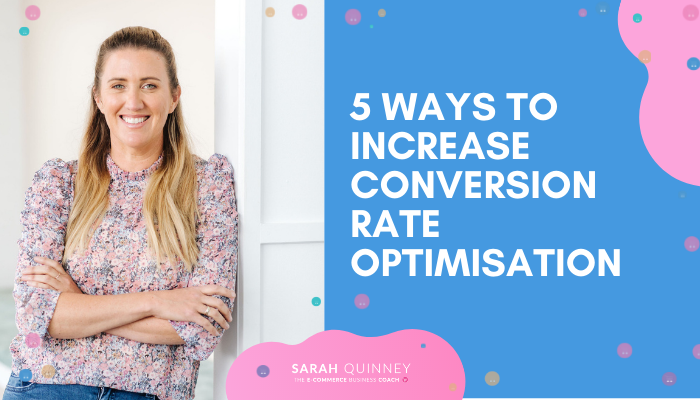
5 Ways to Increase Conversion Rate Optimisation
When it comes to website marketing, most people focus on traffic. They set up advertisements and measures to simply drive clicks and bring people to their store. But to create sales, traffic is only one small part of the process. Many different measures are needed in order to convert that traffic into revenue.
This is where Conversion Rate Optimisation (CRO) becomes important.
Though traffic is an important part of the sales game, it isn’t the only part. Let’s look at CRO and how you can use it to get strategic with your store and work to propel your growth.
What is conversion rate optimisation?
When users land on your website, what do you want them to do? Most likely, you want them to perform an action. This can be signing up for a newsletter, clicking “add to cart,” or purchasing an item. Conversion rate optimisation increases the number of users that do the thing you want them to do.
In math, it looks like this:
Conversion rate % = (# of conversions / total number of visitors) x 100
But, don’t be alarmed if you do the math and find abysmal numbers. In fact, the average conversion rate is quite small and falls somewhere around just 1-3%!
Optimizing your systems to increase that percentage has many benefits, and E-Commerce owners typically consider revenue to be the biggest. With successful optimisation measures, you can tweak a few things to help this percentage increase.
Important elements for effective CRO
Having effective CRO measures in place helps your website do its job. After all, your website is there to sell. Conversion rate optimisation works to make that happen. Let’s look at some methods you can start implementing as early as today.
User Experience (UX) Design
User Experience (UX) design refers to the usability, functionality, and accessibility of a website. Essentially, it looks at how well a website works. Is the flow seamless and easy to use? Is the navigation understandable and easy to find?
To provide a great user experience, your website must engage traffic in all stages of its lifecycle. From first-time visitors to returning customers, make sure your site is easy to navigate by making the entire process simple. Streamline user journeys, place buttons where needed, and make sure your content flows in an understandable way.
Hotjar is an incredibly useful tool that shows what users do on your website. You can see how long they spent on a page, what they looked at, where they clicked, and more. This tool can be a gold mine for learning how users browse through your site. It provides replays of visitor actions and can highlight areas that are more difficult to navigate. It also shows where a user is when they exit your site — that information alone can help you switch things up to encourage users to stick around!
User Interface (UI) Design
Like UX design, User Interface (UI) design is important in converting visitors into leads and ultimately driving sales. UI focuses on the aesthetics of your site and how users navigate it based on the design and overall interactivity.
In terms of CRO, good interface design is a must! Quite simply, if you have a poor visual design, users aren’t going to stick around. You can utilize Hotjar here as well. Gather an idea of what may be driving visitors to stay or leave your site by paying attention to how they use different pages. Check for changes in behavior or time spent on different parts of your site.
If you notice that certain pages aren’t converting as well as others, try to find the reason. Is the page a different design than the others? Maybe you can change the colors or tweak something to eliminate distractions. Play around with it until you find something that sticks.
Remember to pay special attention to your checkout process as well. According to Sleeknote, nearly 70% of carts wind up abandoned. For this reason, streamline your checkout process to eliminate distractions and reduce your abandoned cart rate.
Content
Although the aesthetics of a website can encourage traffic to stick around, aesthetics can’t do it all. A website is simply ineffective if it doesn’t have good content. Great visuals and copy will engage and hook your visitors, giving you a better chance of optimising conversion.
Ensure that your website’s content is up to par by using clear content like high-quality images and attention-grabbing videos. Fonts, element sizing, and colors need to be legible as well.
Similarly, high-quality, strategic copy is essential in getting traffic to follow desired actions rather than clicking away. The writing style itself needs to appeal to your target audience. Effective copy can increase your conversion rate by simply answering the necessary questions your visitors might have. Consider working with a copywriter who can create a copy strategy for your target market.
Calls To Action (CTAs)
Users like to be told what to do. Throughout your website, various calls to action are a must. According to HubSpot, they can make a massive difference, and strategic, personalized versions can even increase conversion by over 200%. CTAs that say things like “subscribe to our newsletter,” can generate more conversion by being direct and to the point.
Be sure to pay attention to what surrounds CTAs. Busy banners, text, and other design elements can pull the attention and disrupt your conversion rate.
Blog
Utilising a website blog is a great way to create another conversion opportunity. When you share content via a blog, you have that much more opportunity to share knowledge, tools, and information with your audience. These are perfect for intertwining with CTAs!
Blogs can also pull traffic to your website because they’re a great tool for utilising search engine optimisation and helping your website rank on Google.
Test it out and see what sticks
Finding the best E-Commerce optimisation options for your store can take time and patience. What works for one site may not necessarily work for you. Test things out, give it time, and see what works. Implement changes slowly so that you can monitor their progress as you go. Google Analytics is great for this.
Gathering data from analytics, click maps, and scroll maps can give you a great understanding of what pages, content, and elements to improve on your website. Test these pages with the changes your data has uncovered to learn what effectively increases your conversion rates.
As best practices are always evolving, make sure to regularly check how your site is performing and update your CRO strategies to reflect any changes in your conversion rates.

Ready to scale your online store?
The E-Commerce Women In Business Mastermind – your exclusive e-commerce coaching and e-commerce digital marketing mentorship for women looking to Grow and Scale your online store. Click here to learn more
Yours in success,
Sarah x
